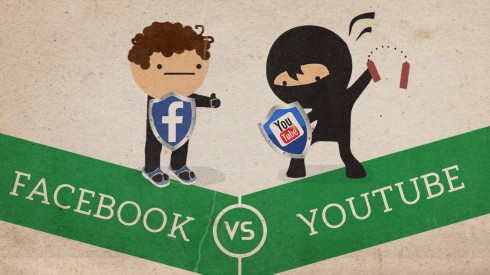By Kenia Gonzalez on 26 Aug 2015

Online video has increased in terms of importance for digital marketers over the past few years. According to Cisco, video will account for 69% of all consumer-based internet traffic by 2017.
The big question for brands is, if you want to deliver your video to right audience where will you promote it? For many of us the first place that comes to mind would be YouTube. This year marked the 10th anniversary of the first video being uploaded to YouTube. For those of you who are curious, it's called "Me at the zoo" and can be viewed below:
Even though YouTube is still the world's biggest online video platform by far, it’s not alone anymore. In the last two years the online video industry has changed significantly. New online video platforms have appeared, such as Vine, Instagram, Snapchat and Facebook Video. From these new online video platforms, Facebook is the first social network to become a real rival of YouTube in terms of online video. Do you remember the ALS Ice Bucket Challenge? It was the biggest viral video not just from last summer, but from all of 2014. Facebook claimed that 440 million viewers watched Ice Bucket videos a total of 10 billion times while YouTube announced only 1 billion Ice Bucket views.
Facebook Video's success hasn’t been limited to just one viral video fad. In fact, views on this platform have continued to grow steadily. By January, Facebook was serving 3 billion video views per day. In April, Facebook reached 4 billion views per day. While this all sounds very impressive and looks to spell bad news for YouTube, these numbers do not take into account the differences in how YouTube and Facebook are counting their views. If we take a closer look, we soon realise that what YouTube call a video view and a what Facebook call a video view are not quite the same.
The first thing we have to consider is that on YouTube advertising a view is counted 30 seconds from when the viewer is engaged (or the full duration of the video if it's shorter than 30 seconds). Facebook, on the other hand, counts a view at the three second mark, which certainly makes their boasting of such high views open to scrutiny (especially when you take autoplay into account). We wanted to know how these differences between YouTube and Facebook's methods of view calculation could affect online video advertising so we conducted some research.
The Wolfgang Experiment
We advertised the same 20 second long video and targeted the same audience for the same period of time via YouTube ads and Facebook Video ads. The only differences were the budgets, so we normalised the results for a common budget of €1,000.
The Findings
When we compared the same promoted video on both platforms, we noticed that the number of impressions on Facebook were 304% higher than on YouTube. This is because the cost per 1,000 impressions (Cost Per Mile) is considerably cheaper on Facebook. YouTube CPM stands at €6.70 whereas Facebook CPM is €1.62, making YouTube around 3 times more expensive than Facebook in this regard.
Video views are a far more important metric than impressions so how did they fare? The view rate on Facebook was approximately double of what we saw on YouTube. Now, let’s compare the Cost Per View (CPV) on both platforms. With a CPV €0.04, YouTube is 751% more expensive than Facebook with a CPV of €0.005. Yes, €0.005 - that's only half a cent per view! (for anyone who thought they saw a typo).
Round 1 goes to Facebook Video. But as we've already mentioned, what counts as a view on Facebook is quite different to what counts as a view on YouTube. This is where our next metric comes in to play; video retention. What percentage of a video was viewed by the user? At the end of the day we want our audience to be engaged with our videos.
We used the same 20 second long video for the next step. In the table below, we can see that there were more people leaving before 25% of the video had played on Facebook. It is natural to expect more people to watch the first 5 seconds of the video on YouTube since they are basically forced to do so (You can skip this ad after 5…4…3…2…please, make it stop...). As time passes, it seems that Facebook users got more engaged with the video. One out of four people finished watching the full video on Facebook whereas approximately one in six people finished watching the full video on YouTube.
Conclusions:
Why are people more engaged with video on Facebook than they are on YouTube?
- Facebook’s interface makes video easier than ever to watch and share.
- The video we promoted had very little or almost no social engagement on YouTube, whereas on Facebook people were sharing, liking and tagging their friends. - I speak for myself, when I say that I am more likely to watch a full video that my friend has posted on his/her wall than anything resembling ‘an ad’.
- It is important to consider that the success of any video campaign on Facebook may vary according to the intention of the video, its quality and how engaging the video is for the audience you are targeting.
- This might not be good news for YouTubers, but it's great news for digital marketers. We can make the most out of our video budgets, giving them wider coverage across different channels while optimising campaigns to their full potential.
Have you any interesting online video insights to share with us? Send us a tweet and we can nerd-bond over them!




.png)
.png)







_2025.png)

